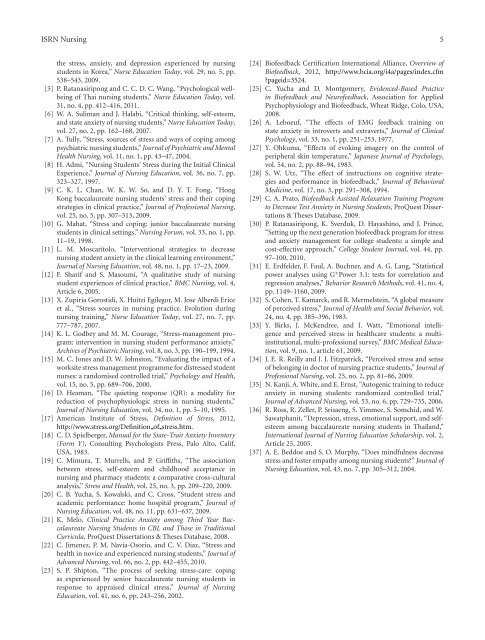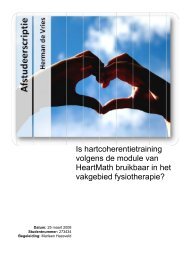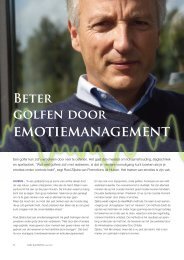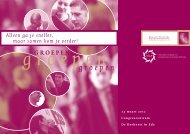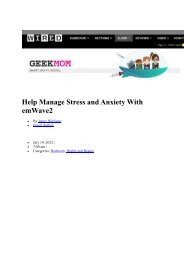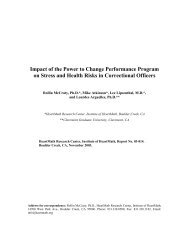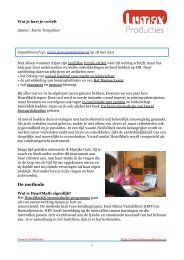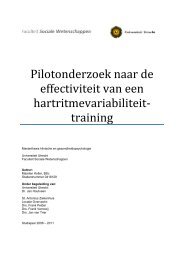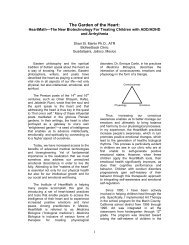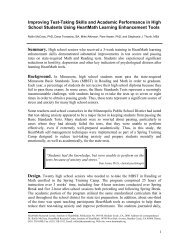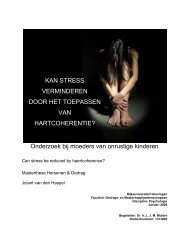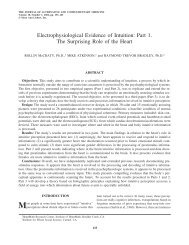Research Article Biofeedback Intervention for Stress and Anxiety ...
Research Article Biofeedback Intervention for Stress and Anxiety ...
Research Article Biofeedback Intervention for Stress and Anxiety ...
Create successful ePaper yourself
Turn your PDF publications into a flip-book with our unique Google optimized e-Paper software.
ISRN Nursing 5the stress, anxiety, <strong>and</strong> depression experienced by nursingstudents in Korea,” Nurse Education Today, vol. 29, no. 5, pp.538–543, 2009.[5] P. Ratanasiripong <strong>and</strong> C. C. D. C. Wang, “Psychological wellbeingof Thai nursing students,” Nurse Education Today, vol.31, no. 4, pp. 412–416, 2011.[6] W. A. Suliman <strong>and</strong> J. Halabi, “Critical thinking, self-esteem,<strong>and</strong> state anxiety of nursing students,” Nurse Education Today,vol. 27, no. 2, pp. 162–168, 2007.[7] A. Tully, “<strong>Stress</strong>, sources of stress <strong>and</strong> ways of coping amongpsychiatric nursing students,” Journal of Psychiatric <strong>and</strong> MentalHealth Nursing,vol.11,no.1,pp.43–47,2004.[8] H. Admi, “Nursing Students’ <strong>Stress</strong> during the Initial ClinicalExperience,” Journal of Nursing Education, vol. 36, no. 7, pp.323–327, 1997.[9] C. K. L. Chan, W. K. W. So, <strong>and</strong> D. Y. T. Fong, “HongKong baccalaureate nursing students’ stress <strong>and</strong> their copingstrategies in clinical practice,” Journal of Professional Nursing,vol. 25, no. 5, pp. 307–313, 2009.[10] G. Mahat, “<strong>Stress</strong> <strong>and</strong> coping: junior baccalaureate nursingstudents in clinical settings,” Nursing Forum, vol. 33, no. 1, pp.11–19, 1998.[11] L. M. Moscaritolo, “<strong>Intervention</strong>al strategies to decreasenursing student anxiety in the clinical learning environment,”Journal of Nursing Education,vol.48,no.1,pp.17–23,2009.[12] F. Sharif <strong>and</strong> S. Masoumi, “A qualitative study of nursingstudent experiences of clinical practice,” BMC Nursing, vol.4,<strong>Article</strong> 6, 2005.[13] X. Zupiria Gorostidi, X. Huitzi Egilegor, M. Jose Alberdi Ericeet al., “<strong>Stress</strong> sources in nursing practice. Evolution duringnursing training,” Nurse Education Today, vol. 27, no. 7, pp.777–787, 2007.[14] K. L. Godbey <strong>and</strong> M. M. Courage, “<strong>Stress</strong>-management program:intervention in nursing student per<strong>for</strong>mance anxiety,”Archives of Psychiatric Nursing,vol.8,no.3,pp.190–199,1994.[15] M. C. Jones <strong>and</strong> D. W. Johnston, “Evaluating the impact of aworksite stress management programme <strong>for</strong> distressed studentnurses: a r<strong>and</strong>omised controlled trial,” Psychology <strong>and</strong> Health,vol. 15, no. 5, pp. 689–706, 2000.[16] D. Heaman, “The quieting response (QR): a modality <strong>for</strong>reduction of psychophysiologic stress in nursing students,”Journal of Nursing Education,vol.34,no.1,pp.5–10,1995.[17] American Institute of <strong>Stress</strong>, Definition of <strong>Stress</strong>, 2012,http://www.stress.org/Definition of stress.htm.[18] C. D. Spielberger, Manual <strong>for</strong> the State-Trait <strong>Anxiety</strong> Inventory(Form Y), Consulting Psychologists Press, Palo Alto, Calif,USA, 1983.[19] C. Mimura, T. Murrells, <strong>and</strong> P. Griffiths, “The associationbetween stress, self-esteem <strong>and</strong> childhood acceptance innursing <strong>and</strong> pharmacy students: a comparative cross-culturalanalysis,” <strong>Stress</strong> <strong>and</strong> Health,vol.25,no.3,pp.209–220,2009.[20] C. B. Yucha, S. Kowalski, <strong>and</strong> C. Cross, “Student stress <strong>and</strong>academic per<strong>for</strong>mance: home hospital program,” Journal ofNursing Education,vol.48,no.11,pp.631–637,2009.[21] K. Melo, Clinical Practice <strong>Anxiety</strong> among Third Year BaccalaureateNursing Students in CBL <strong>and</strong> Those in TraditionalCurricula,ProQuestDissertations&ThesesDatabase,2008.[22] C. Jimenez, P. M. Navia-Osorio, <strong>and</strong> C. V. Diaz, “<strong>Stress</strong> <strong>and</strong>health in novice <strong>and</strong> experienced nursing students,” Journal ofAdvanced Nursing,vol.66,no.2,pp.442–455,2010.[23] S. P. Shipton, “The process of seeking stress-care: copingas experienced by senior baccalaureate nursing students inresponse to appraised clinical stress,” Journal of NursingEducation,vol.41,no.6,pp.243–256,2002.[24] <strong>Biofeedback</strong> Certification International Alliance, Overview of<strong>Biofeedback</strong>, 2012, http://www.bcia.org/i4a/pages/index.cfm?pageid=3524.[25] C. Yucha <strong>and</strong> D. Montgomery, Evidenced-Based Practicein <strong>Biofeedback</strong> <strong>and</strong> Neurofeedback, Association<strong>for</strong>AppliedPsychophysiology <strong>and</strong> <strong>Biofeedback</strong>, Wheat Ridge, Colo, USA,2008.[26] A. Leboeuf, “The effects of EMG feedback training onstate anxiety in introverts <strong>and</strong> extraverts,” Journal of ClinicalPsychology,vol.33,no.1,pp.251–253,1977.[27] Y. Ohkuma, “Effects of evoking imagery on the control ofperipheral skin temperature,” Japanese Journal of Psychology,vol. 54, no. 2, pp. 88–94, 1983.[28] S. W. Utz, “The effect of instructions on cognitive strategies<strong>and</strong> per<strong>for</strong>mance in biofeedback,” Journal of BehavioralMedicine,vol.17,no.3,pp.291–308,1994.[29] C. A. Prato, <strong>Biofeedback</strong> Assisted Relaxation Training Programto Decrease Test <strong>Anxiety</strong> in Nursing Students, ProQuest Dissertations& Theses Database, 2009.[30] P. Ratanasiripong, K. Sverduk, D. Hayashino, <strong>and</strong> J. Prince,“Setting up the next generation biofeedback program <strong>for</strong> stress<strong>and</strong> anxiety management <strong>for</strong> college students: a simple <strong>and</strong>cost-effective approach,” College Student Journal, vol.44,pp.97–100, 2010.[31] E. Erdfelder, F. Faul, A. Buchner, <strong>and</strong> A. G. Lang, “Statisticalpower analyses using G ∗ Power 3.1: tests <strong>for</strong> correlation <strong>and</strong>regression analyses,” Behavior <strong>Research</strong> Methods, vol. 41, no. 4,pp. 1149–1160, 2009.[32] S. Cohen, T. Kamarck, <strong>and</strong> R. Mermelstein, “A global measureof perceived stress,” Journal of Health <strong>and</strong> Social Behavior,vol.24, no. 4, pp. 385–396, 1983.[33] Y. Birks, J. McKendree, <strong>and</strong> I. Watt, “Emotional intelligence<strong>and</strong> perceived stress in healthcare students: a multiinstitutional,multi-professional survey,” BMC Medical Education,vol.9,no.1,article61,2009.[34] J. E. R. Reilly <strong>and</strong> J. J. Fitzpatrick, “Perceived stress <strong>and</strong> senseof belonging in doctor of nursing practice students,” Journal ofProfessional Nursing,vol.25,no.2,pp.81–86,2009.[35] N. Kanji, A. White, <strong>and</strong> E. Ernst, “Autogenic training to reduceanxiety in nursing students: r<strong>and</strong>omized controlled trial,”Journal of Advanced Nursing,vol.53,no.6,pp.729–735,2006.[36] R. Ross, R. Zeller, P. Srisaeng, S. Yimmee, S. Somchid, <strong>and</strong> W.Sawatphanit, “Depression, stress, emotional support, <strong>and</strong> selfesteemamong baccalaureate nursing students in Thail<strong>and</strong>,”International Journal of Nursing Education Scholarship, vol.2,<strong>Article</strong> 25, 2005.[37] A. E. Beddoe <strong>and</strong> S. O. Murphy, “Does mindfulness decreasestress <strong>and</strong> foster empathy among nursing students?” Journal ofNursing Education,vol.43,no.7,pp.305–312,2004.


